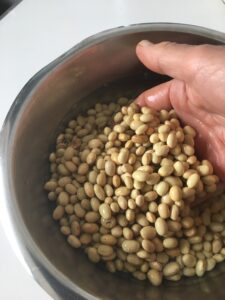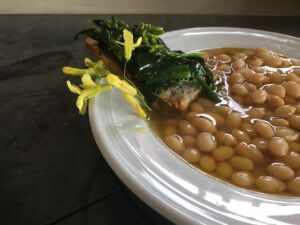#cookathome ep.2 – zolfini beans & cavolo nero
A healthy recipe with typical beans and cavolo nero (black kale) from the Tuscan region. No beans and cavolo nero at home? Print the for future use….
Zolfini beans with cavolo nero
A healthy recipe with typical beans and kale from the Tuscan region. Zolfini are old traditional beans from some specific areas of Tuscany. The name derives from the element sulfur (zolfo in italian) that is yellowish like these beans. They are produced in limited quantities, therefor they are quite expensive and rare to find: use cannellini beans as an alternative.Cavolo nero is a winter vegetable, originally from Tuscany, but now available in most italian regions. It is not uncommon to find it also in the spring. Also its yellow flowers are edible. Use other varieties of kale if cavolo nero is not available.The accompanying bread and the fruit dessert make this a very balanced and healthy meal.
Yield: 6 people
Calories: 800kcal
Materials
- 500 g zolfini beans (dry) or white cannellini beans (dry)
- water
- 2 cloves garlic
- 10 leaves sage
- 1 tbsp EVO oil
- 10-15 grains black pepper in grains
- salt as little as possible
cavolo nero
- 900 g cavolo nero (black kale)
- 2 cloves garlic
- 1 hot pepper
- 6 tbsp EVO oil
- salt as little as possible
bread and condiments
- 600 g whole wheat bread
- 6 tbsp EVO oil
- pepper to taste
dessert
- 900 g strawberries
Instructions
the beans
- zolfini and cannellini beans do not need soaking, but for best results cook very slowly for a long time.

- put the beans in a large pot, with water (approx 4 parts of water for 1 part of beans). Add garlic, sage, oil.
- bring to a boil, lower the flame to a minimum, simmer for 2-3 hours. The beans should become very soft but should stay whole. Add some salt, to taste, only if needed, when ready.
the cavolo nero
- separate the leaves of the cavolo nero from the stems and wash them. If you have small, tender leaves just wash them as they are. If you have the classical long leaves, then you need to check if the stems are too hard and stringy. In that case, discard all stringy parts, but keep them aside for a mixed soup. Remember to always wash your vegetables carefully, changing the water 2, 3 or more times, until the rinsing water comes out clean (at least apparently). You may want to blanch the leaves in hot water for a few minutes, but only if the are big and hard. Keep the water. Finally, cut the large leaves to even pieces, according to your preference.

- chop the garlic and the hot pepper. Put then in a large pan with olive oli. Add the leaves. Stir fry gently until tender, adding some water (or the broth from the blanching) if needed. The less you cook your veggies the better.
serving
- in the mean time, slice the bread and roast it.
- put some cavolo nero on 6 of the roasted bread slices. Pour the beans (with some of the broth) on each dish and serve with the cavolo nero crouton. Season with EVO oil and pepper.

- serve the rest of the bread and kale separately, or make more croutons.
dessert
- rinse the strawberries, without leaving them in the water for too long time. Change the water 2 or 3 times. Drain them.
- Serve as they are and enjoy!
Notes
A very balanced meal, rich in protein, fiber and vitamins.
Cavolo nero, and most of the veggies in the cabbage family (brassica/cruciferous), are rich in lutein, a carotenoid that has shown to have protective properties for the eyes.
One serving of this meal (including the fruit) provides:
| Daily reference values for a 2000 kcal diet | |||
| Energy | 757 kcal | 38 % | |
| Protein | 34 g | 68 % | |
| Fat | 24 g | 34 % | |
| saturated fat | 3.7 g | 19 % | |
| Carbohydrates | 108 g | 42 % | |
| sugars | 17 g | 19 % | |
| Fibre | 27 g | 109 % | |
| Salt | 1.9 g | 33 % | |
| Vitamin C | 201 mg | 251 % | |
| Folate | 313 µg | 156 % | |
| Vitamin A | 204 µg | 26 % | |
| Vitamin E | 7.4 mg | 62 % | |
| Fe | 11 mg | 81 % | |
| Ca | 311 mg | 39 % | |
| K | 2183 mg | 109 % | |



